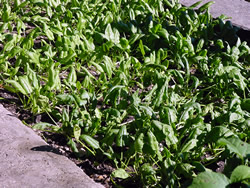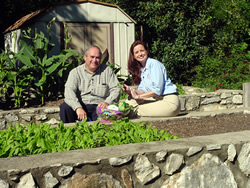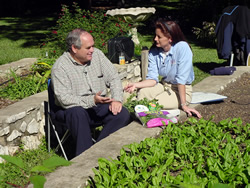| To be aware of and concerned about one's health, fitness, and
life is the latest "fad" in America. A strong part of
this "new" awareness is the understanding that in order
for the body to thrive and perform, it must be well nourished, rather
than just well fed.
 But
what exactly does nutrition mean? The dictionary defines it as
the process by which the food material taken into an organism
is converted into living tissue. The USDA simplifies this by saying
that food is essential for the energy we need to move, breathe,
think, and grow. The nutrients in food maintain the building,
the upkeep, and the repair of the body tissue as well as the basic
functions of the body. But
what exactly does nutrition mean? The dictionary defines it as
the process by which the food material taken into an organism
is converted into living tissue. The USDA simplifies this by saying
that food is essential for the energy we need to move, breathe,
think, and grow. The nutrients in food maintain the building,
the upkeep, and the repair of the body tissue as well as the basic
functions of the body.
The nutrients which the USDA finds valuable for good health are:
food energy, expressed in calories; protein, fat and fiber; calcium,
phosphorus, iron, sodium, potassium, thiamin (Vitamin B-1), riboflavin
(Vitamin B-2), niacin, ascorbic acid (Vitamin C), and beta-carotene
(Vitamin A).
 America
is in love with salads. The fast food restaurants have salad bars
now which makes it easy to enjoy a quick lunch of fresh, tasty
vegetables. Whether you're creating that salad at a restaurant
or in your own kitchen, it is good to know what is nutritional. America
is in love with salads. The fast food restaurants have salad bars
now which makes it easy to enjoy a quick lunch of fresh, tasty
vegetables. Whether you're creating that salad at a restaurant
or in your own kitchen, it is good to know what is nutritional.
The main ingredient of a salad is obviously the leafy stuff.
Most of us are proficient at growing the salad additives such
as tomatoes, broccoli and carrots but I will bet my hat that few
of us have grown an acceptable lettuce crop. By "acceptable"
I mean crunchy and sweet - - anyone can grow leaf lettuce and
it tastes as its name implies, like leaves. Most of us want crunch
and sweet when we eat lettuce. The best way to get both is not
to grow lettuce but to grow spinach.
Nutritionally speaking, spinach is a super-champ of the vegetable
garden. Spinach has twice as much protein, calcium, iron, potassium,
Vitamin A, Vitamin B, and B-2, niacin and Vitamin C as any other
of the leafy greens.
Spinach is easy to grow especially in this area of Texas. Commercial
growers in this area produce 90 percent of all the spinach consumed
in the United States and almost 50 percent of the entire world's
supply.
Spinach is an unusual vegetable. It shares the honor with asparagus
of being a dioecious plant. That is, unisexual with pollen-producing
male flowers on one plant and seed-bearing female flowers on a
separate plant. Spinach is classified as a "very hardy cool
season crop." Although it can be grown almost anywhere in
the Unites States, it does best at a mean temperature of 50 to
60 degrees F. If planted in late spring, when hot weather is approaching,
the plant will quickly form a flower stalk, going to seed after
the development of only a few leaves.
Spinach varieties are available in flat-leaved, semi- crinkle-leaved
(semi-savoy) and crinkle-leaved (savoy) types. The flat-leaved
types are best suited for canning and the crinkle- leaved types
are best for fresh use. Because of the fungus diseases which damage
spinach growth and leaf appearance, only certain varieties should
be used. Spinach is a cool-season crop which should be planted
from seed in September. Spinach seed germinates very poorly in
warm soils. Therefore, to avoid a poor stand, the first planting
should occur when soil temperatures are 75 degrees F. or below
which is now the case. Soil temperatures in this range will occur
about 8 weeks prior to the first anticipated fall frost.
Additional plantings can be made up until about 6 to 8 weeks
before temperatures are expected to drop near 20 degrees F. at
which temperature spinach is often damaged or even killed. Gardeners
in this area can continue planting right through winter and into
early spring. Spinach should always be seeded directly in your
garden. Ideally, there should be sufficient moisture in the soil
at planting time to result in germination and emergence of the
seedling without having to apply additional water. If soil is
too dry when it's time to plant, consider watering several days
or so before planting to supply the needed moisture. Applying
water after planting to supply the moisture needed for germination
often causes seedling diseases and is best avoided.
The seed can be scattered or broadcast over the top of the bed,
or it can be planted in rows. Generally, planting in rows is preferable
since weeds which emerge near the spinach seedlings can be more
easily removed. If your planting bed is about 20 inches wide,
4 rows of spinach can be seeded across the top, leaving plenty
of room for the plants to develop.
Regardless of your planting system, the seed should be covered
to a depth of one-half inch. Always use more seed than needed
to ensure a good stand. Depending upon conditions, the seedlings
should be up in about 7 to 10 days. About 2 weeks after emergence,
thin the seedlings to a spacing of 4 to 6 inches apart.
About 10 days to 2 weeks after thinning, you should stimulate
the growth of your spinach with a light application of nitrogen
fertilizer. Use about one-half pound of ammonium sulfate (21-0-0)
for each 30 feet of row planted in spinach. Apply the fertilizer
to the side of the plants and then water it in lightly.
As your crop of spinach grows, its important that you provide
sufficient soil moisture. Remember that spinach has a rather shallow
and limited root system, with most of the feeder roots in the
top 8 to 10 inches of soil. Therefore, frequent watering is necessary.
Approximately 6 to 10 weeks after planting, depending upon the
variety and the weather, it's harvest time. You'll note that as
the weather cools down your spinach will take a little longer
to fully mature and will grow more upright. Generally, spinach
that matures when temperatures average between 50 degrees and
60 degrees F. will be fuller-bodied and of higher quality.
Harvesting is usually done either by removing the older, outer
leaves, or by pulling up the whole plant. A third method that
works quite well is to harvest foliage with a sharp knife, leaving
the crown or growing point of the plant and roots in place so
that a second crop can be produced by the same plant. A light
application of fertilizer (ammonium sulfate) and watering should
follow this type of harvest to encourage new leaf growth. Europeans
and Americans eat the leaves which are dark green with rounded
leaf edges. However, entire plants with red roots and dandelion-like
leaves are preferred in Japan. The simplest and most nutritious
way to eat spinach is raw in salad substituted for, or with, lettuce.
When cooking spinach, care should be taken not to overcook it,
boiling away flavor and nutrients. To cook it successfully, wash
and put it in a covered pan with only the water clinging to the
leaves. Steam over a medium flame for 3 to 5 minutes. Butter,
bacon bits, or sauteed onions can be added for complementary flavoring.
More elaborate spinach dishes include Eggs Florentine (poached
eggs placed in spinach and hollandaise sauce), spinach-stuffed
tomatoes, spinach quiche and spinach fondue. Other interesting
dishes are spinach potato soup, spinach cheese balls deep fat
fried, spinach-shrimp omelet ring, spinach and chicken or ham
- - Chinese style, spinach and shredded beet ring, and spinach-tuna
salad.
So, if you're not already growing some, plant and start eating
nutritious spinach - - insure a sweet crunch.
To view a Comparison of Spinach and Lettuce Nutrients,
please click here.
Spinach Recipes:/Recipes/spinach/spinach&lettucenutrition.html
|
Leaf Spinach (Blattspinat)
|
2 lb+ leaf spinach
2 medium onions
3 oz butter or margarine
Salt
Freshly ground pepper
Grated nutmeg
Cooking time
Variation: 3 peeled, crushed garlic cloves 2 tbsp pine kernels |
Sort and wash the spinach and place in a colander. Peel
and dice the onions. Melt the butter or margarine in a large
saucepan and sautJ the onion; add the wet spinach. Season
with salt, freshly ground pepper and grated nutmeg and cook
over a low heat, stirring carefully. Season with salt and
pepper to taste. 5-10 minutesSautJ the garlic with the onions.
Lightly roast the pine nuts in a dry saucepan and serve with
the spinach. |
| Vegetables are best prepared by 1) cleaning
immediately before use; 2) washing before cutting; 3) never
leaving to soak in cold water, but briefly rinsing under cold
running water; 4) cook gently, braised in their own juices,
steaming or in foil. Cook "al dente" or for a short
time so that they retain their minerals and fresh colour.
from Dr. Oetker German Cooking Today-The Original by Ceres
Verlag, English translation copyright1997, Bielefeld, Germany.
|
|
Spinach Hollandia
|
2 lbs fresh spinach (or 2 packages
at10 oz.ea)
4 slices bacon, diced 2 tablespoons wine or cider vinegar
¾ teaspoon salt
¼ teaspoon pepper |
1. Remove any coarse outer leaves and stems
from the spinach; wash leaves well; drain. Pile into a large
skillet. (No need to add any water.) Cover.
2. Bring to boiling, then steam 3 minutes, or just until leaves
wilt; drain well.
3. While the spinach cooks, saute bacon until crisp in a small
skillet; drain on paper towel. Remove pan from heat; pour
off all drippings, then measure 3 tablespoonsfuls back into
the pan.
4. Stir in vinegar, salt and pepper; pour over the drained
spinach; add bacon and toss lightly to coat well. Serves 6. |
| from The Family Circle Cookbook
by the Food Editors of Family Circle Magazine and Jean Anderson.
1974. |
For a step-by-step procedure to grow spinach, follow the recommendations
for Mustard and Turnips at this
link..
More Recipes......
Chicken and Spinach Lasagna
Use the type of pasta that you don't have to cook ahead, and the
recipe will be even easier to make. It also can be made ahead
and frozen for up to a month.
1 tablespoon butter or margarine
½ large onion
1 cup mushrooms, sliced
1 (10 1/4-ounce) can cream of chicken soup, undiluted
1 (16-ounce) jar Alfredo sauce
1 (4-ounce) jar diced pimento, drained
1/3 cup dry white wine
½ teaspoon dried basil
1 (10-ounce) package frozen chopped spinach, thawed
1 (15-ounce) container ricotta cheese
½ cup grated Parmesan cheese
1 large egg, lightly beaten
9 lasagna noodles, cooked, or use a no-bake variety
2½ cups cooked chicken, shredded
3 cups shredded sharp Cheddar cheese
Melt butter in a skillet over medium-high heat. Add onion and
mushrooms and saute' until tender. Stir in soup, Alfredo sauce,
pimento, wine and basil. Reserve one cup of this mixture for top
of lasagna. Drain thawed spinach well by pressing between layers
of paper towels. Stir spinach, ricotta cheese, Parmesan and egg
together. Place 3 lasagna noodles in a lightly greased 13-by-9-inch
baking dish. Layer with half each of the sauce, spinach mixture
and chicken. Sprinkle one with 1 cup of the Cheddar.
Repeat procedure.
Top with remaining 3 noodles and reserved sauce. Cover and chill
for up to one day ahead or cover tightly and freeze for up to
one month. Bake in preheated 350-degree F. oven 45 minutes.
Sprinkle with remaining 1 cup Cheddar, and bake for approximately
5 to 10 more minutes until cheese is melted. Let stand 10 minutes
before serving.
Makes 8-10 servings
==============================
SPINACH SALAD with RASPBERRY VINAIGRETTE
From Country Lifestyle
1 bag spinach
2 heads Boston lettuce
Kiwi
1 pint strawberries
avocados
2 tablespoons toasted almonds
2 cups raspberry vinaigrette
Wash and break Boston lettuce, remove stem and wash spinach.
Slice kiwi, strawberries, and avocados. Marinate avocados in raspberry
vinaigrette. Toss all ingredients together and top with raspberry
vinaigrette then serve........Country Lifestyle
============================
RASPBERRY VINAIGRETTE DRESSING
1 cup raspberry wine vinegar
2-1/2 cup salad oil
1 cup sugar
2 tablespoon sesame seeds
2 tablespoons poppy seeds
1 tablespoon Worchestershire Sauce
1 tablespoon paprika
Mix raspberry white vinegar, sugar, sesame, seeds, poppy seeds,
Worchestershire sauce and paprika together. Slowly add salad oil,
mixing well till thick. Pour dressing over spinach salad and serve.
*NOTE: Do not pour dressing over salad until ready to serve.==============================
Strawberry Spinach Salad
Shirley Johnson, retired from the Texas Cooperative Extension
DRESSING
½ cup sugar
1 tablespoon poppy seeds
2 tablespoons sesame seeds
1½ tablespoons minced onions
1/4 teaspoon paprika
1/4 cup cider vinegar
1/4 cup white wine vinegar
½ cup oil
SALAD
1 bag baby spinach
1 bag spring greens
3/4 cup sliced almonds
1 pint strawberries
2 tablespoons butter
Mix all the ingredients for the dressing and set aside.
Saute/toast almonds in butter (be careful not to burn almonds)
Slice strawberries
Mix the greens, spinach, strawberries and almonds.
Add the dressing.
Serves about 6-8
===============================
SPINACH SALAD
Judy Edwards, retired from Texas Cooperative Extension
1 pound fresh spinach -I love the baby spinach when I can get
it 4 hard cooked eggs, mashed
8 to 10 strips bacon, cooked and crumbled (reserve 2 Tablespoons
of drippings)
1 to 1 ½ cups of fresh mushrooms, sliced
Dressing:½ cup of vinegar
1 cup of sugar
1 teaspoon of salt
1 teaspoon paprika
½ teaspoon of prepared mustard
½ onion, cut into chunks
1½ cups salad oil
2 Tablespoons of bacon drippings
Wash spinach. Drain and tear into bite size pieces. Refrigerate.
Combine and dissolve dressing ingredients except onion, oil and
drippings in saucepan. Boil for 1 minute. Cool to lukewarm. Pour
into blender. Add onion. Pulverize. Continue blending while adding
oil and drippings. Pour over spinach just before serving. Sprinkle
eggs and bacon over top. Serves 8.
The dressing makes quite a lot, and I keep it in the refrigerator
all the time. It is always very popular when I take it places.
Lots of times I use Mandarin oranges and red onion rings rather
than the bacon and eggs, etc. OR 1 can water of chestnuts, 5 strips
bacon and ½ cup of chopped green onion make good additions
to a pound of fresh spinach. It's pretty hard to mess up spinach
as far as I am concerned!
==============================
Florentine Artichoke Dip
Spinach, artichoke hearts, and two cheeses blend beautifully
in this dippers.
1 (10-ounce) package frozen chopped spinach, thawed
2 (6 ½-ounce) jars marinated artichoke hearts, drained
and chopped
1½ (8-ounce) packages cream cheese, softened
1 cup freshly shredded Parmesan cheese
½ cup mayonnaise
3 large garlic cloves, pressed
2 tablespoons of lemon juice
1½ cups French bread crumbs (homemade) (See Note)
2 tablespoons butter or margarine, melted
DRAIN spinach; press between layers of paper towels to remove
excess moisture.
COMBINE spinach, artichoke hearts, and next 5 ingredients in
a bowl, stirring well. Spoon into a lightly greased 11 inch x
7 inch baking dish. Combine bread crumbs and butter; sprinkle
over spinach mixture.
BAKE, uncovered, at 375 degrees F. for 25 minutes. Serve with
assorted crackers, bagel chips, or bread sticks. Yield: 4 cups.
NOTE: To get 1½ cups of French bread crumbs, tear off a
piece of a baguette. Pulse in a food processor until coarse crumbs
form. Measure crumbs, tear off another chunk, and repeat procedure
until you get 1½ cups.
=============================
Leaf Spinach (Blattspinat)
2 lb+ leaf spinach
2 medium onions
3 oz butter or margarine
Salt
Freshly ground pepper
Grated nutmeg
Cooking time
Variation: 3 peeled, crushed garlic cloves
2 Tablespoons pine kernels
Sort and wash the spinach and place in a colander. Peel and
dice the onions. Melt the butter or margarine in a large saucepan
and sauté the onion; add the wet spinach. Season with salt,
freshly ground pepper and grated nutmeg and cook over a low heat,
stirring carefully. Season with salt and pepper to taste. 5-10
minutes Sauté the garlic with the onions. Lightly roast
the pine nuts in a dry saucepan and serve with the spinach.
Vegetables are best prepared by 1) cleaning immediately before
use; 2) washing before cutting; 3) never leaving to soak in cold
water, but briefly rinsing under cold running water; 4) cook gently,
braised in their own juices, steaming or in foil. Cook for a short
time so that they retain their minerals and fresh color.
from Dr. Oetker German Cooking Today-The Original by Ceres Verlag,
English translation copyright1997, Bielefeld, Germany.
================================
Spinach Hollandia
2 lbs fresh spinach (or 2 packages at10 oz.ea)
4 slices bacon, diced
2 tablespoons wine or cider vinegar
¾ teaspoon salt
¼ teaspoon pepper
1. Remove any coarse outer leaves and stems from the spinach;
wash leaves well; drain. Pile into a large skillet. (No need to
add any water.) Cover.
2. Bring to boiling, then steam 3 minutes, or just until leaves
wilt; drain well.
3. While the spinach cooks, sauté bacon until crisp in
a small skillet; drain on paper towel. Remove pan from heat; pour
off all drippings, then measure 3 tablespoonsfuls back into the
pan.
4. Stir in vinegar, salt and pepper; pour over the drained spinach;
add bacon and toss lightly to coat well.
Serves 6.
from The Family Circle Cookbook by the Food Editors of Family
Circle Magazine and Jean Anderson. 1974.
|



